Investors always have a lot on their minds, particularly when it comes to saving for retirement. They’re always trying to figure out which way markets will move, when they’ll move, and what assets they should invest in to maximize their retirement savings. The more uncertainty faces them, the more difficult their investment decision making becomes.
In the aftermath of the financial crisis, it wasn’t at all obvious that stock markets were a good place to invest. Millions of investors were burned badly, losing significant portions of their investments. But for the past four years many investors have made great gains in markets, with stocks now at all-time highs.
Now investors are wondering what the coming year will hold, as 2020 seems to hold a great deal of uncertainty. Here are five of the top issues that will face investors in the coming year.
1. Sky-High Stock Markets
Stock markets remain at all-time highs, despite all the negative economic and political news. Declining manufacturing, the prospect of war, and continuing tariffs seem only to make temporary dents in stock market gains. But while stock markets continue to gain, investors know that it’s only a matter of time before they drop again. The only question is when, and what will be the trigger.
Many investors realize that corporate stock buybacks are what has driven stock markets over the past several years, with corporations issuing cheap debt and using the money raised to buy back their stocks. With the Federal Reserve having recently opened up the monetary spigots once again, hundreds of billions of dollars of new money is flooding into the financial system, with stock markets rising and falling based on how much money and credit the Federal Reserve creates.
When that flow of easy money ends, so will the stock market boom. Many investors want to ride the bull until the very end, but they may wait too late and end up losing money once markets begin to crash.
2. Slowing Economy
Economies around the world are slowing, an ominous sign for their health and strength. Manufacturing activity continues to decline, and shipments of goods by train, truck, and ship continue to plummet. While the US economy hasn’t entered recession yet, other economies have. It’s only a matter of time before the US succumbs to the growing economic malaise.
3. Tariffs
Despite the coming signing of the first phase of a trade deal, tariffs on Chinese imports remain. With tariffs on imports of steel from Brazil and Argentina still in place, plus the likelihood of new tariffs on imports from France, tariffs will remain a major headwind that will weigh on the economy.
Tariffs are always paid by the consumer, and US consumers have been hit hard thus far, with billions of dollars worth of tariffs driving up the cost of the goods they have come to rely on. More tariffs can come at any time, for any reason, and the effect of additional tariffs will increase costs to American consumers.
That will also continue to weigh on American businesses, which have already seen the prices of various production inputs rising. Continuation of tariffs will only make doing business in the US more expensive than it is already. And it remains to be seen how many US farmers will remain in business this year after the double whammy of Chinese tariffs and bad weather in 2019.
4. Geopolitical Uncertainty
If someone had told you a year ago that the US would kill an Iranian general and that Iran would retaliate by launching missiles at US bases in Iraq, you probably would have laughed. While Iran has long been a bogeyman, no one ever thought that conflict with Iran would lead to a shooting war. Yet here we are, and any day the conflict with Iran can break out into something larger. Just imagine what would happen if US troops were killed by Iranian missiles, or if a US facility in Iraq were overrun by Shiite militias.
Then add in Venezuela, North Korea, and all the other potential flash points and you have the potential for serious geopolitical conflict. Any conflict in those areas has the potential to bring the great powers to war against each other, something that would be incredibly destructive to the world economy and to investors’ portfolios.
5. Monetary Policy
With a return to loose monetary policy, the Federal Reserve System has juiced stock markets. Despite wave after wave of negative economic and political news, stock markets keep ticking higher. Analysts who have looked at the correlation between the Fed’s money creation and stock markets see that stock markets track almost identically with the Fed’s monetary policy. But the Fed can’t keep creating money forever. Once the gravy train ends, stock markets will sink. What will the Fed do then?
Markets are already beginning to price in interest rate cuts, but merely cutting interest rates to zero may not be enough for the Fed this time around. There’s a very real threat that the Fed might decide to introduce negative interest rates, something that would be disastrous for savers and investors.
With so many issues facing investors this year, it could be a very interesting one. Anyone expecting 30% returns in stock markets like last year should prepare to be disappointed. But one asset that will likely make great gains is gold. Gold was up 15% last year despite the fact that stock markets were also booming, and the geopolitical conflict in the Middle East has already driven gold up significantly so far this year. So if you’re looking for an asset to protect the value of your investment portfolio against all the potential headwinds you’ll face, investing in gold may be just what you need.
This article was originally posted on Goldco.



